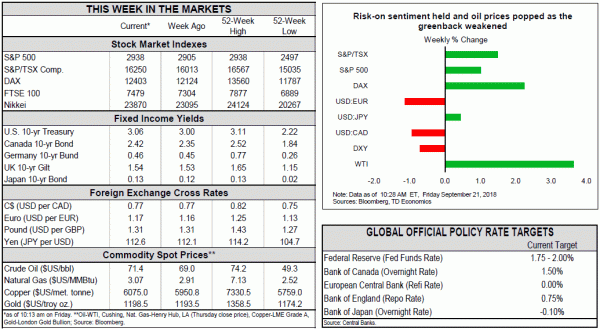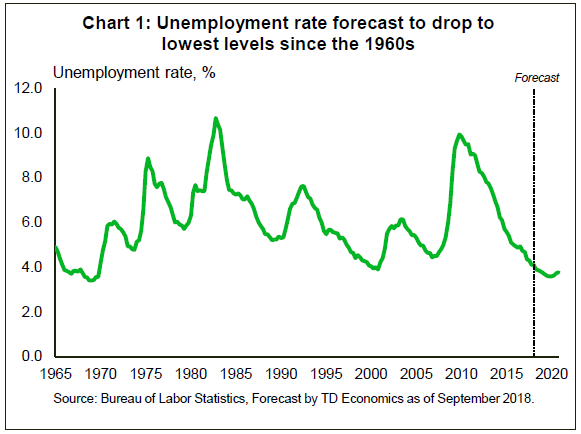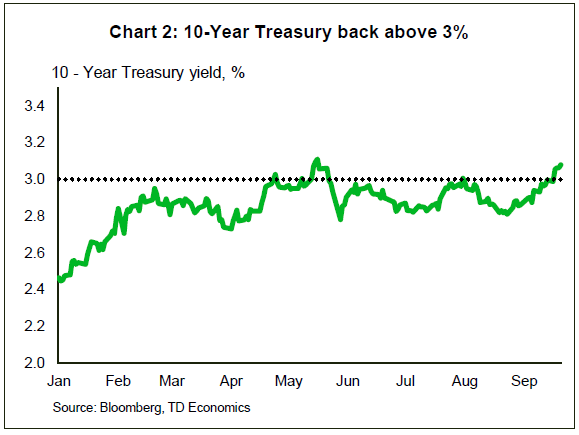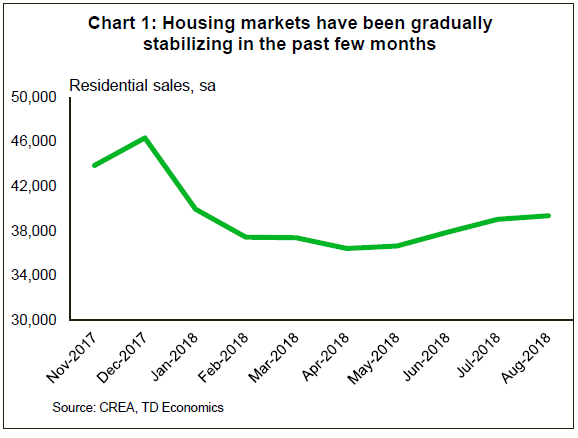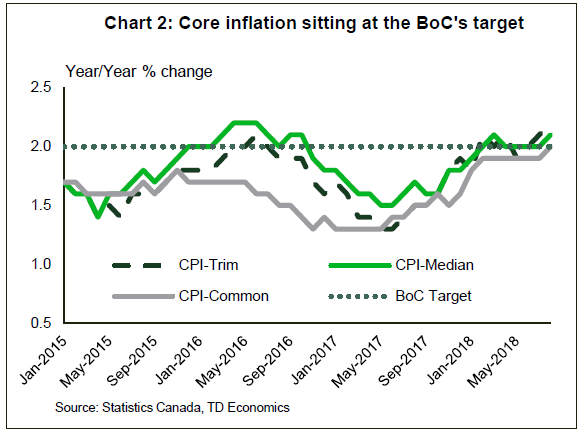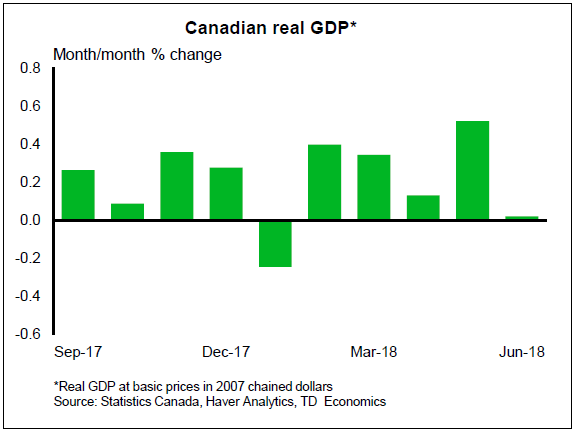U.S. Highlights
- U.S. equity markets were unbowed by escalating trade actions between the U.S. and China this week. The S&P500 reached new highs bolstered by healthy earnings reports and growth in share buybacks.
- Equity market optimism is backed up by an economy set to grow by an impressive 2.9% this year, boosted by fiscal stimulus. The Fed is expected to respond to consistently above-trend growth with another 25 basis point rate hike next week, taking the upper limit of the fed funds rate to 2.25%.
- Our latest forecast does not include the impacts of the latest tit for tat tariffs between the U.S. and China. If the current tranche plays out as planned, it could weigh notably on growth at the same time as the fiscal sugar rush fades.
Canadian Highlights
- It was a decent week for Canadian data, with manufacturing sales surprising on the upside and pointing to a positive Q3, alongside decent retail sales.
- Adding to the busy economic calendar was an existing home sales print that reinforced the post-B20 housing market stabilization narrative, and core CPI measures sitting at the BoC’s target.
- NAFTA talks stole the show this week, with no clear end in sight as Canada emphasized the importance of a good deal irrespective of looming deadlines.
U.S. – Market Optimism Unbowed by Trade Risks
Neither escalating trade wars, devastating hurricanes, rising interest rates, nor tumultuous emerging markets prevented the S&P500 from attaining new heights this week. Strong corporate earnings growth is playing a key role, as is a 50% increase in share buybacks over the first half of 2018. Thanks to tax cuts, corporations are awash with cash, and have managed to increase capital expenditures and return money to shareholders.
Strength in equity markets is backed up by a very healthy U.S. economy. Our latest Quarterly Forecast outlines how fiscal stimulus is helping to boost real GDP growth to 2.9% this year. Growth well above potential is expected to push the unemployment rate to the lowest level since Woodstock (Chart 1). With the economic party raging, the Federal Reserve is widely expected to drain some more punch from the bowl next Wednesday. A 25 basis-point rate hike will raise the fed funds rate to 2.00-2.25%, marking the eighth rate hike since 2015. We expect the Fed to hike four more times over the next year, placing the fed funds target at a peak level of 3.25% in 2019.
Next week’s decision looks like a done deal, but the Fed’s economic forecast will still be closely watched. Now that another tranche of tariffs on Chinese imports and China’s retaliatory measures are on the books, it will be interesting to see how FOMC members adjust their outlook, if at all. Our forecast calls for growth on a quarterly basis to slow from roughly 3% in the second half of 2018 to below 2% by 2020. Those numbers do not include the impact from the latest round of tit for tat tariffs.
If the 10% tariff on roughly $200bn in Chinese imports run their stated course, and rise to 25% on January 1st, we estimate that U.S. real GDP growth could be knocked back by roughly 0.4 percentage points over a 4-6 quarter period. The peak impact would occur at roughly the same time as the waning impact of fiscal stimulus measures exerts a drag on growth. Those two headwinds could hold the economy back to a very anemic 1.5% pace by early 2020.
In the event of full escalation of the U.S.-China trade war, where the administration follows through on its threat of tariffs on a further $267bn in Chinese imports, the economic hit would double to 0.8 percentage points in total. That could push US growth closer to 1%. For now, it seems financial markets do not think that this outcome is too likely, but forecasters are becoming increasingly concerned about the risks to growth in 2019. The OECD lowered its targets for global growth slightly in its outlook published this week. It now expects the global economy to grow by 3.7% next year, down two ticks from its 3.9% forecast back in May citing downside risks from trade.
We also expect global growth to moderate next year to 3.6%, due to weakening emerging market momentum, without the impact from escalating China-U.S. trade tensions. The path forward on tariffs is not written in stone, and hopefully if the political rhetoric cools down after the U.S. mid-term elections in November, cooler heads might also prevail at the trade negotiation table.
Canada – Positive Data Releases Overshadowed by NAFTA
It was a busy week on the Canadian data front, with financial markets and trade negotiations offering an added element of excitement. A run in healthcare, financials, and energy, amongst others, helped to move the S&P/TSX up to its highest level this month – climbing more than 1.3% so far on the week (as of 10AM). This was coupled with a jump in WTI prices above the $70 mark on the wake of Iranian supply concerns. Finally, the loonie gained on the week, due in part to risk-on sentiment weakening the greenback, increases in oil prices, and the market shrugging off trade uncertainty.
On the data front, releases this week solidify our view that macroeconomic fundamentals remain strong in Canada. As discussed in our latest Quarterly Economic Forecast, our 2018 and 2019 GDP forecasts were modestly revised upward to allow for new cannabis accounting, in addition to some slight additional upside in housing market momentum.
To that point, kicking off the release schedule was a home sales print of +0.9% month-on-month in August, its fourth consecutive increase. Especially notable were gains in some of British Columbia’s markets, the hardest-hit by a combination of federal and provincial regulations. Once again, the release adds more evidence that housing markets are recovering from the late-2017 macro-prudential measures, and are on track to add some modest upside to growth.
Meanwhile, manufacturing sales were particularly impressive, rising 1% in real terms in July and boosted further by an upward revision to the previous month’s data. Retail sales met expectations with a modest 0.3% increase in July – although volumes were flat. Dissecting the monthly noise, the trend in both indicators offers a consistent healthy picture of an economy overcoming ongoing headwinds and transitory factors (tariffs, outages, rising interest rates).
Wrapping it all up was perhaps the week’s most watched release: consumer price inflation. Coming in at 2.8% year-over-year in August, headline inflation declined slightly from July, signaling that last month’s gasoline and transportation spikes were only a transitory bump. More importantly, the Bank of Canada’s target measures all hovered around its 2% target, with CPI-Common sitting exactly at 2%. Taking the two together, the release reinforces the narrative that the economy is operating at or above capacity.
All told, the wealth of generally positive releases confirms our view on the BoC’s next move. An October rate hike has likely been sealed barring any exceptional releases. That said, the timing and pace of further hikes is not as clear-cut. With inflation not showing any pressing movements, and with trade uncertainty still a factor, rate hikes are likely to be more gradual in 2019. Indeed, the BoC has cited trade uncertainty as one of its most-watched developments in the medium and long term. As we saw from yet another week with little progress on NAFTA negotiations, this uncertainty may be sticking around for some time yet.
Canada: Upcoming Key Economic Releases
Canadian Real GDP – July
Release Date: September 28, 2018
Previous: 0.0% m/m
TD Forecast: -0.1% m/m
Consensus: N/A
Industry-level GDP is set to post a modest 0.1% decline in July on weakness in the energy sector after power outages curtailed output from a large producer in the oil sands. The pullback in energy output will leave services to drive growth while manufacturing and utilities provide a modest offset. A country-wide heat wave will provide a key tailwind to the latter, though it also threatens residential construction due to unfavourable working conditions. Weakness in the energy sector should be temporary, and we look for output in the oil sands to bounce back in the coming months. Furthermore, we expect the BoC to look through such distortions ahead of the October meeting. The 1.5% forecast for Q3 from the July MPR indicates that they’ve already penciled in some downside for July and Senior Deputy Governor Wilkins recently said she expects growth to average 2% over H2, implying a rebound in Q4.




